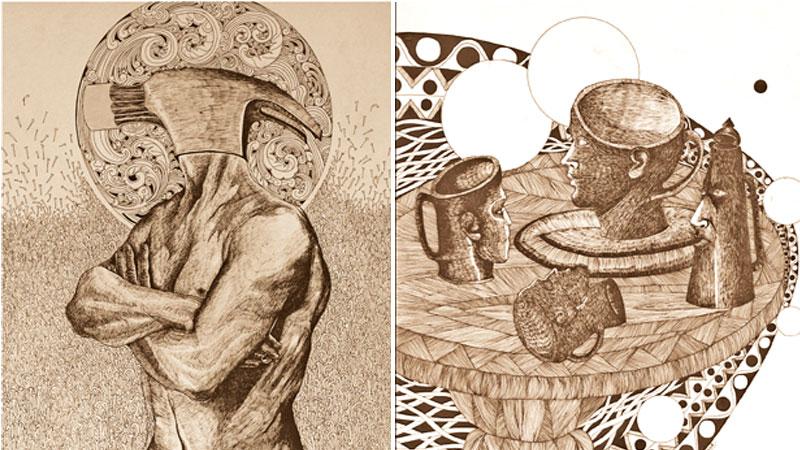
Starting January 10 you can visit the ‘Composite Figures’ art exhibition at the Paradise Road Gallery. The exhibition will remain open throughout the month.
It is the pulse of the artist that you perceive in a work of art. The moments of life are captured forever. Unseen words of a soul painted in different colours depict the unspeakable mysteries, the pain, happiness, love, anguish, horror and suffering. Art is universal, and is explicit in different forms as an attempt of the artist. These explorers of creativity are the creators of new forms of art.
 Prasad Weerasinghe is a young artist who sketches composite drawings by combining 18th century traditional temple art decorations. A set designer and art director at the Sri Lanka Rupavahini Corporation, he continues his research on art. After graduating from the University of Colombo, he now pursues his Master’s degree on Art History. Allied to the subject area he has organized an art exhibition that depicts the reality of society.
Prasad Weerasinghe is a young artist who sketches composite drawings by combining 18th century traditional temple art decorations. A set designer and art director at the Sri Lanka Rupavahini Corporation, he continues his research on art. After graduating from the University of Colombo, he now pursues his Master’s degree on Art History. Allied to the subject area he has organized an art exhibition that depicts the reality of society.
Starting January 10 you can visit the ‘Composite Figures’ art exhibition at the Paradise Road Gallery. The exhibition will remain open throughout the month.
Prasad has proved his excellence by winning many awards. In 2003 he received the Best Award in the State May Day Art Competition; in 2007 he won second place in the State Art and Sculpture Festival. In 2008, he was awarded first place in the Annual Art and Craft Exhibition organised by the Ceylon Society of Arts in Sri Lanka and third place in the State Art and Sculpture Festival 2017, organised by the Cultural Department.
Art is a kind of meditation, which enables the discovery of one’s self. You have the power to express emotion in your own way. Composite drawings are a way of art which was created joining different shapes into one. This combination of shapes depicts meaningful thoughts on the viewer. “Composite drawings are quite extensive. Within that range I picked the 18th century traditional temple decorations. The specialty is, it consists of old drawings such as, Makara Roopaya, Gajasingha Roopaya, Naarilatha Pushpaya, Vrushabha Kunjaraya and Kinnara Roopaya.
They portray the reactions of human beings under political, economic, social and cultural influences. On the other hand, it showcases the downfall of morality and humanity. Numerous messages are evoked through this pictorial language. I studied the creations of Leonardo da Vinci, Alfred Duroux, Bridget Riley to get the real taste of composite figures,” says Prasad.
To bring the optical phenomena that allow the artist to direct the eye of the viewer, he uses different kinds of aspects such as, shape, colour, texture, value, form and space. In his creations the viewer unconsciously reads the different elements that are contrasted by the colours. Here, the lines have taken direct attention towards the main subject of the picture, or contribute in dividing the big picture into compartments. Lines sans a clear subject point suggest the chaos and the conflict in image. Compared with straight lines, curves provide dynamic influences which are aesthetically pleasing. Not only lines, the intensity and the strength of colour are also important. “I have used colours such as black, white and silver. I have used a limited number of colours to make it more real and deep,” says Prasad.
The lightness and the darkness of colour also have the ability to express emotions and create moods. Also, it creates value in visual art. In addition, it contrasts an important factor in the creation of two dimension artwork.

His art is exceptional as it highlights the depth of the drawing by using all the elements in composite figures. Forms in his composite drawing is numerous. If you have a close look, you may see geometric forms that have beautified the picture. Space in a piece of art cannot be ignored.
This element in visual art can be positive or negative, open or closed, shallow or deep, and two-dimensional or three-dimensional.
Prasad’s expression of art conveys the unspoken syllables as the voice of an artist is not heard, but seen on a piece of paper. They are the ones who create something out of nothing.
A sculptor has the magical power to turn a useless, rough, formless piece of rock into an alluring sculpture. In the same way the painter is the one who frees the caged thoughts on a subtle piece of paper.
